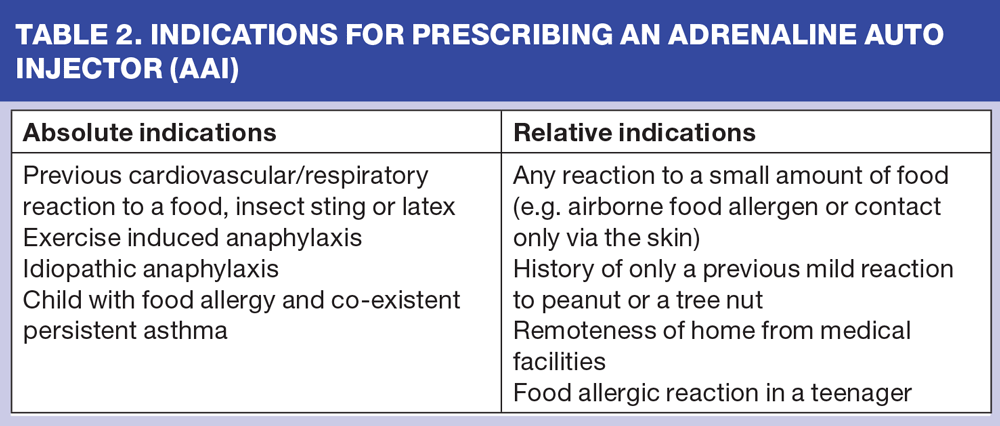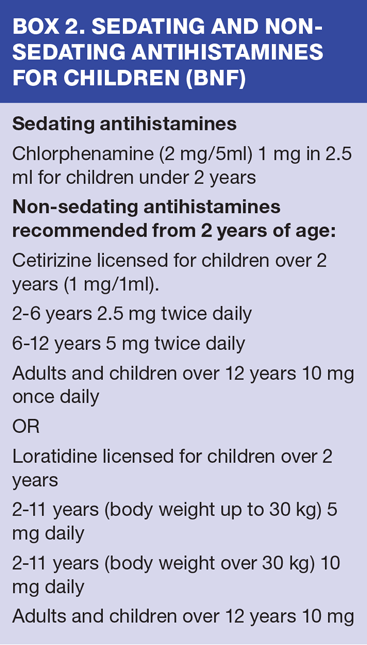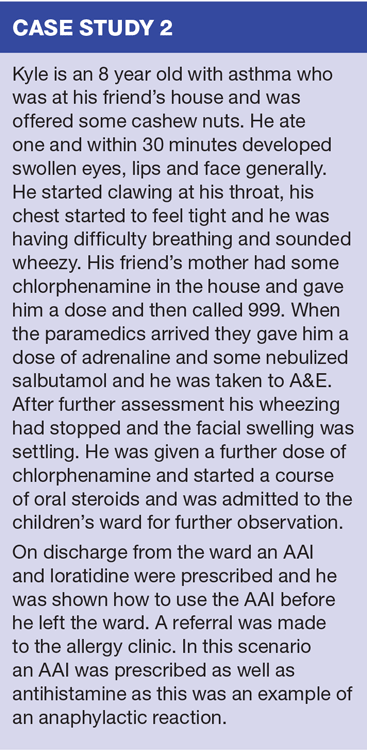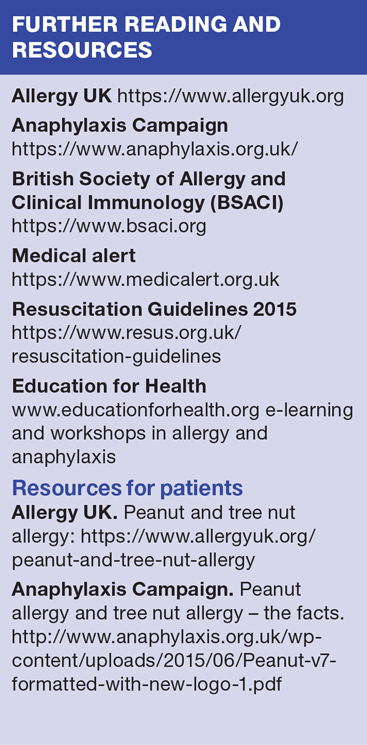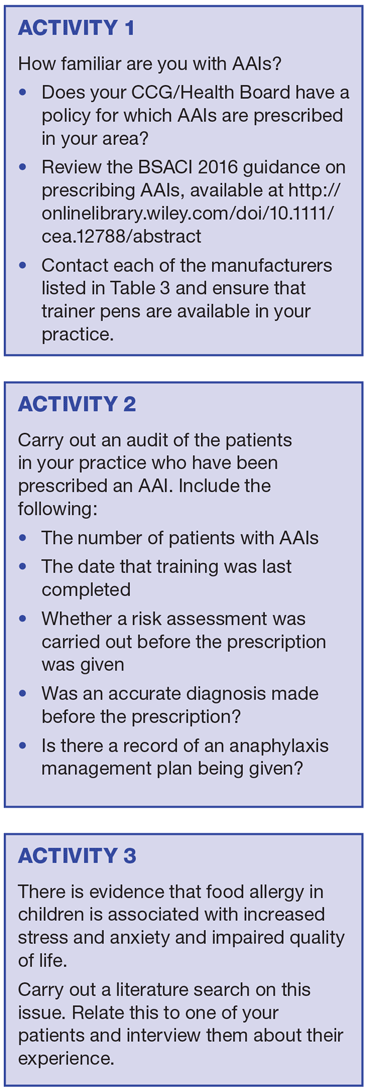
Nut allergy in children: a growing concern
Celia Proudfoot
Celia Proudfoot
RGN/RSCN MSc
Clinical Nurse Specialist- allergy
Paediatric Allergy Clinic
Countess of Chester Hospital
Dr Peter Saul
MB CHB DCH FRCGP
Allergy Lead
Paediatric Allergy Clinic
Countess of Chester Hospital
Peanut and tree nut allergy are increasing in prevalence, particularly among children, and at this time of year, when many households have nuts as part of their Christmas fare, the risk is – at least theoretically – increased. Primary care has an important role in identifying and managing these children in the long term, in order to prevent fatal food-induced anaphylaxis
Peanut and tree nut allergies are potentially life threatening, can start at an early age and are rarely outgrown. They are among the leading causes of fatal food-induced anaphylaxis and are increasing in prevalence, especially in children. Once diagnosed these children require careful management in the form of nut avoidance and rescue medication. Primary care clinicians have an important role in the identification and long term management of patients and their families.
This article discusses the prevalence, mechanisms and management of this increasingly important area and a glossary of terms related to allergy is given in Box 1.
PREVALENCE
In the UK peanut allergy affects between 0.5%-1.85% of children.1 It presents most commonly in the first five years of life, often after the first known ingestion.2
RISK FACTORS
Eczema is a significant risk factor, raising the possibility of initial exposure occurring through an impaired skin barrier.3 The use of emollient creams containing peanut oil are thought by some to be problematic,4 although this is disputed by others. Egg allergy is another risk factor,4 and peanut allergy is a risk factor for the development of tree nut allergy.5
Prognostic factors for more severe reactions are:6,7
- A previous severe reaction
- A clinical history of asthma
- Teenage and young adult years (due to risky behaviours).
PEANUTS AND TREE NUTS
Peanuts are not true nuts but legumes, like soy and beans. Tree nuts are hard shelled fruit from trees and include hazel nuts and walnuts. Cross reactivity can occur between peanuts and other members of the legume family and occasionally some peanut allergic individuals will also be sensitive to tree nuts despite the fact that these are genetically unrelated.8
A list of legumes is included in Table 1.
Cross reactivity can occur between tree nuts; for example, patients with cashew nut allergy almost always have clinical reactivity to pistachio nut.9 Cashew sensitivity is of increasing importance because of its tendency to cause more severe reactions and its increasing prevalence.10 This is also the case with brazil nut allergy.
Despite their names coconuts and pine nuts are not tree nuts but seeds.
ALLERGY MECHANISMS
Nut allergy is an adverse clinical reaction of an immunological nature, induced by nut protein and mediated by specific IgE antibodies.
All IgE-mediated reactions require prior sensitisation to the allergen. Sensitisation can occur via the skin (such as when an infant has an impaired skin barrier due to eczema), gastrointestinal or respiratory routes. The sensitisation process involves the production of IgE antibodies to specific allergens and their attachment to IgE receptor cells such as mast cells. These then become ‘primed’ with specific IgE antibodies on the surface. Following subsequent exposure to the allergen, linkage occurs with the IgE receptor, triggering mast cell degranulation. Degranulation results in the release of various chemical substances, notably histamine and other chemicals such as prostaglandins, leukotrienes and enzymes. These are responsible for the symptoms of:
- Vasodilatation (redness)
- Irritation of nerve endings (itching)
- Increased vascular permeability (swelling)
- Leaking of plasma (hypotension, collapse).
Signs and symptoms of an allergic reaction can be multi organ in nature and include the following:
- Circulation – hypotension, collapse, shock
- Gastrointestinal tract – nausea, vomiting, abdominal pain, diarrhoea
- Airways – wheeze, cough, stridor, laryngeal oedema
- Skin – urticaria, oedema, flushing/erythema.
PRESENTATION
Primary care clinicians typically become involved either directly or indirectly: directly following contact by the parents who relate symptoms after exposure to nuts; or indirectly after a child has attended hospital following an allergic reaction. NICE recommends follow up to identify the culprit allergen, to give specific avoidance advice (preferably with the support of a dietitian) and to agree an anaphylaxis management plan.11
Where there has been initial direct contact in primary care, history taking is important and will help further management. With children first seen in a hospital setting, explanation, reassurance and management planning are the key elements.
HISTORY TAKING
The diagnosis of nut allergy relies on an association between contact with an allergen and typical clinical features. In primary care, confirmation of raised serum IgE is helpful and skin prick tests may be used in secondary care.
A good, focused history should include:
- Atopic history
- Personal and family history of atopy
- Previous feeding history
- Other allergies: foods, medicines, aeroallergens
- Previous history of a similar event (with the same or another food)
- Known intolerance to other nuts
- Details of the event
- Where did it happen?
- What was the person doing/eating at the time?
- Amount eaten to cause the reaction?
- Time between eating the food and the reaction?
- Type of reaction (mild, moderate or severe)?
- What treatment, if any, was given and response to it
- What happened next
- Was hospitalisation needed (or any other medical advice/review sought)?
- How long were they unwell?
INVESTIGATION
Serum specific IgE should be available in primary care settings and is the investigation of choice. However, the use of investigations must be informed by the clinical history and only suspected allergens tested for. These tests have high sensitivity but low specificity so are not helpful without a clear history. Positive results may reflect sensitisation rather than true allergy and can sometimes confuse matters.12 Local allergy services will often provide helpful telephone advice for interpreting results, if needed.
MANAGEMENT
Once the diagnosis has been confirmed there are four key elements to the management of nut allergy:
1. Risk assessment
2. Management plan which includes
a. Nut avoidance
b. Rescue medication
3. Possible dietetic referral
4. Ongoing support and education for child and parents.
1. Risk assessment
Reactions following minimal contact, a history of asthma, previous anaphylactic reaction, being a teenager and geographical remoteness all place a child at additional risk. Additionally parent/patient anxiety may need to be taken into account.
Where there are additional risk factors, urgent referral to an allergy clinic is advised. With children at lower risk, some may be managed entirely in primary care although best practice would be to refer to an allergy clinic.
2. Management plan
This is essential prior to allergy clinic assessment. It should include basic information about nut allergy, advice on nut avoidance, how suspected allergic reactions should be treated and provision of, and training in, emergency medications. Typically these should include an antihistamine and reliever inhaler (if asthma or wheezing has been a problem). Provision of an adrenaline auto injector (AAI) may be considered in high risk or high anxiety situations but is ideally left to the allergy clinic. The British Society of Allergy and Clinical Immunology (BSACI) offers advice on management plans and has also recently issued advice on the prescription of AAIs (Table 2).
a. Nut avoidance
Unlike other common childhood food allergies, such as egg and milk, resolution of nut allergy is uncommon so long term nut avoidance advice is the cornerstone of management.13 There is plenty of online advice about avoidance to which parents can be directed. (See Resources)
There are some key points to cover:
- Parents and older children should be aware that peanut can be given other names including monkey nuts, arachis, earthnut and groundnut, and they should know how to recognise the nut.
- Food label awareness is important. All nuts included in food must be labelled in bold type. Additionally precautionary advisory labelling, which refers to statements such as ‘may contain’ or ‘not suitable for’, must be present.14 Patients and parents should be advised to read both on any food product they intend to consume, even if it has been consumed before as recipes can change. Refined peanut oil would normally be safe but pressed or unrefined oils are allergenic.8
- Some skin preparations may contain arachis oil and, while there is little concrete evidence that they are harmful, they are probably best avoided.
Eating out
Nut avoidance has many pitfalls, especially when it comes to takeaways and eating out. Chinese, Indian and Thai foods may be particularly problematic. The main risks are from inadvertent inclusion or cross-contamination of food with an allergen. Knowledgeable and trustworthy staff are essential for safety.
Establishments with defined menus, structured food processing and risk assessment procedures are likely to be better suited to the needs of nut allergic patients. Small restaurants, takeaways and bakeries may have less support for staff to ensure which foods are allergen free. In such situations a dialogue with serving staff is essential. If there are residual doubts then alternative products should be sought.
Single versus all nut exclusion
When advice is being given by practice based clinicians the simplest strategy is for patients to initially be told to avoid all nuts and nut traces. Strict rules minimise risk and give a simple message.13
This advice may, however, be modified at the allergy clinic. There is an ongoing debate among allergists about the strictness of avoidance policy. Complete nut avoidance is very restrictive, particularly with respect to many pre-packed foods, and is extremely difficult to achieve. Many allergists suggest that if a person is known to be tolerant of specific nuts they can continue to eat them but to be aware of the risks of cross contamination with the nuts to which they are allergic.15
b. Rescue medication16,17
Antihistamines
The British National Formulary recommendations for sedating and non-sedating antihistamines in children are summarised in Box 2.
Adrenaline Auto Injectors
Where an AAI is prescribed, three are commonly used:
- Epipen: 0.15 mg adrenaline < 30 Kg; 0.3 mg adrenaline >30 Kgs
- Jext: 0.15 mg adrenaline < 30 Kg; 0.3 mg adrenaline >30 Kgs
- Emerade: 0.15mg adrenaline 15-30Kg; 0.3-0.5mg adrenaline >30Kgs.
Each has a different device and they should not therefore be switched without proper training. CCGs and health boards often have local prescribing policies based on cost and shelf life. Devices, doses and the manufacturers’ website addresses can be found in Table 3.
3. Dietetic referral
Dietitians have a key role in management. They can give more detailed advice on nut avoidance and the reading of food labels.
4. On-going support and education for child and parents
Nut allergy has been shown to result in high anxiety levels in parent and child, and families may need regular support from practice nurses as well as the allergy clinic. Nut allergy can lead to a significant psychological burden as well as social and dietary restrictions that may affect quality of life.18 Hospital follow up is typically every year or two, so intervening checks may be valuable. This is particularly important where an AAI device has been prescribed.
The latest guidelines, recommend the provision of a single AAI at each location where the child spends significant time (typically home and school).19 Where there is geographical remoteness a second device should be considered in case a subsequent dose is needed and an ambulance is distant.
Consideration of re-testing and re-challenge is best left to the allergy clinic.
As a practice nurse you may need to liaise with school nurse colleagues and hospital clinicians to ensure that all concerned are up to date with the current management, and have access to a copy of the anaphylaxis management plan. Practice nurses can also assist with asthma follow up and ensure that asthma is optimally controlled.
PREVENTION AND DISEASE MODIFICATION
Prevention
Nut avoidance for mothers and infants has not reduced the incidence of nut allergy. Recently the LEAP (Learning Early About Peanut Allergy) study has identified that early exposure of at risk infants to peanuts in the first few months of life can reduce peanut allergy.20
Disease modification
An estimated 20% of children will outgrow their peanut allergy,21 but in our clinical practice this appears to be considerably less. Treatment strategies currently focus on the role of immunotherapy, whose aim is to increase tolerance but not to cure.
Peanut oral immunotherapy can induce desensitisation in 60% of peanut allergic children, but consumption must be maintained to sustain tolerance.21 At present there is, unfortunately, no marketed product available in oral or subcutaneous form.
SUMMARY
Peanut and tree nut allergy is an increasing problem and a leading cause of fatal, food-induced anaphylaxis. The reason for this is a subject of ongoing debate and research.
For primary care practitioners, including practice nurses, the ongoing support of families affected is an important role. Nut allergy can have a considerable, detrimental effect on both the individual and their family. They need consistent and clear advice to help them avoid the offending allergen and, most importantly, a management plan for how to deal with emergency situations needs to be agreed and regularly reinforced.
REFERENCES
1. Venter C, Hasan AS, Grundy J, et al. Time trends in the prevalence of peanut allergy: three cohorts of children from the same geographical location in the UK. Allergy 2010; 65(1):103-8.
2. Osborne NJ, Koplin JJ, Martin PE, et al. Prevalence of challenge-proven IgE-mediated food allergy using population-based sampling and predetermined challenge criteria in infants. J Allergy Clin Immun 2011;127(3):668-76.
3. Lack G. Epidemiologic risks for food allergy. J Allergy Clin Immun 2008; 121(6):1331-6.
4. Lack G, Fox D, Northstone K, Golding J. Factors associated with the development of peanut allergy in childhood. N Engl J Med 2003; 348(11):977-85.
5. Clark AT, Ewan PW. The development and progression of allergy to multiple nuts at different ages. Pediatr Allergy Immun 2005;16(6):507-11
6. Umasunthar T. Incidence of food anaphylaxis in people with food allergy: a systematic review and meta-analysis. Clin Exp Allergy 2013;43 (12): 1333-41
7. Simons FE, Ardusso LR, Bilo MB, et al. World allergy organization guidelines for the assessment and management of anaphylaxis. World Allergy Organisation 2011; 4(2):13-37.
8. Peanut and Tree Nut allergy. www.allergyuk.org
9. Hasegawa M, Inomata N, Yamazaki H, et al Clinical features of four cases with cashew nut allergy and cross reactivity between cashew nut and pistachio. Allergology Int 2011; Dec. 60 (4): 425-32.
10. Clark AT, Anagostou K, Ewan PW. Cashew nut causes more severe reactions than peanut: case matched comparison in 141 children. Allergy 2007; 62 (8): 913-698
11. NICE CG134. Anaphylaxis: assessment and referral after emergency treatment, 2011. https://www.nice.org.uk/guidance/cg134
12. Clark AT, Ewan PW. Interpretation of tests for nut allergy in one thousand patients, in relation to allergy or tolerance. Clin Exper Allergy 2003; 33(8):1041-5
13. Anagnostou K, Clark A. The management of peanut allergy. Arch Dis Child 2015; 100:68–72.
14. Food Standard Agency. Food allergen labelling technical guidance. 2015.
15. Brough HA, Turner PJ, Fox AT, et al. Dietary management of peanut and tree nut allergy: what exactly should patients avoid? Clin Exper Allergy 2015; 45(5):859-71
16. BNF for Children September 2015-2016 www.bnfc.org
17. BNF September 2016 www.bnf.org
18. Cummings AJ, Knibb RC, King RM, et al. The psychosocial impact of food allergy and food hypersensitivity in children, adolescents and their families: a review. Allergy 2010; 65(8):933
19. Ewan P, Braithwaite N, Leech S, et al. British Society for Allergy and Clinical Immunology (BSACI) guidelines: prescribing Adrenaline Auto Injectors. Clin Exper Allergy 2016; 46 (10) 1258-1280.
20. Du Toit G, Katz Y, Sasieni P, et al. Early consumption of peanuts in infancy is associated with a low prevalence of peanut allergy. J Allergy Clin Immun 2008; 122(5):984-91.
21. Clark AT, Islam S, King Y, et al. Successful oral tolerance induction in severe peanut allergy. Allergy 2009;64(8):1218-20.



